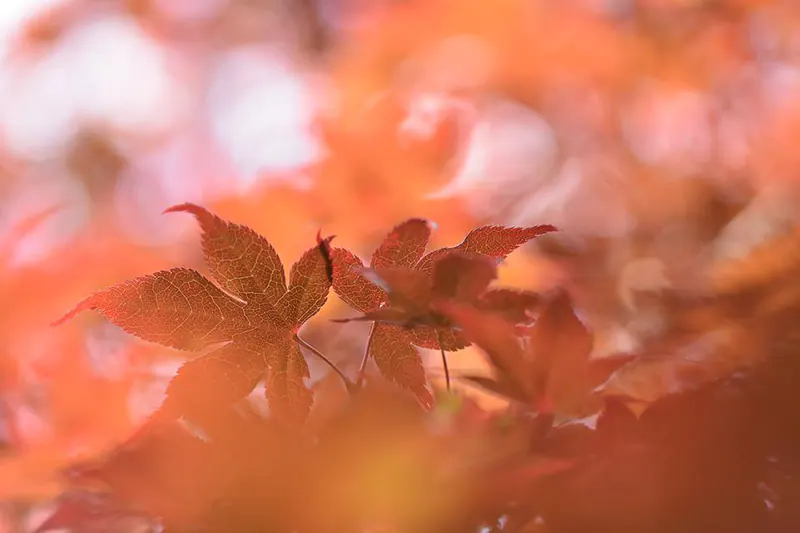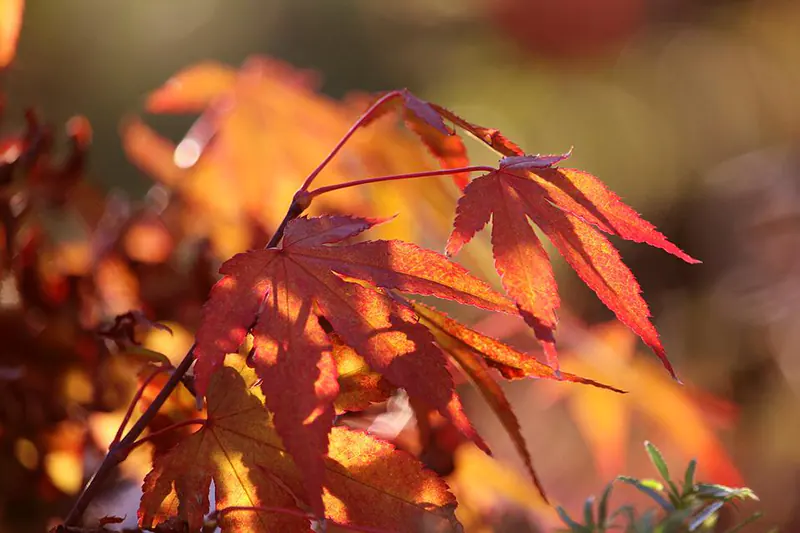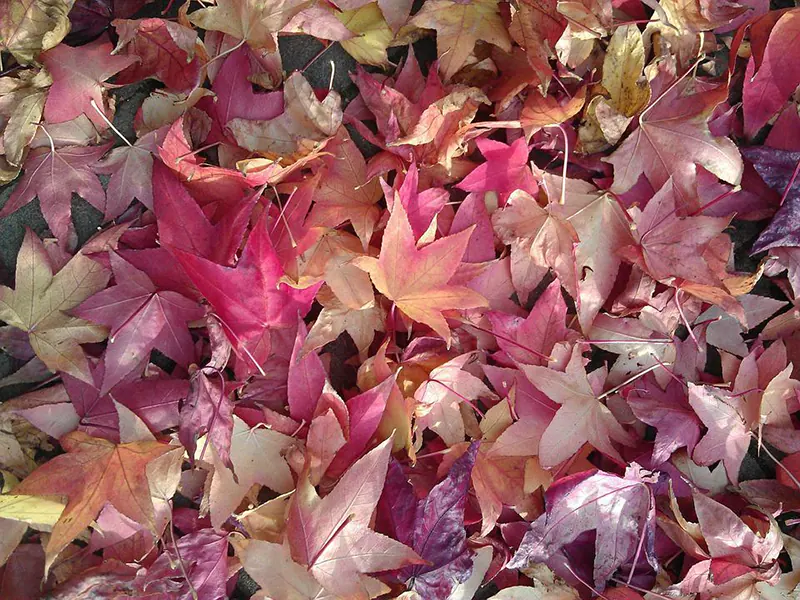How To Identify A Japanese Maple?
Japanese maple can be planted as a small tree or large shrubs and grow up to 15 to 25 feet tall. The branches are broadly rounded and exist in layers.
Japanese maple trees are easy to spot with colorful leaves and smaller than other trees. These flowering trees are native to Japan. We have coiled down different features to help you identify your Japanese maple.

Japanese Maple Foliage
It is easy to point out the Japanese maple leaves from their shape and colors. The main distinguishing factor is the lobes that can be five up to seven per leave, the beautiful colors of each tree, and the leaf blades. These trees may differ with each leaf type: palm-shaped and delicate laceleaf.
Palm-shaped maples are the Palmates or the Acer palmatum and are characterized by broad, serrated leaves. Leaves may start showing as early as spring, and the color differs with seasons. In summer, the leaves are green, whereas, in fall, they display different colors varying from orange, yellow, red, and purple.
Flowers And Fruits
Japanese Maples are known for their hermaphrodite nature, which means they have both female and male reproductive systems. The flowers are very small and hardly attract any insects. The flowers produced by these trees are purple ad sometimes reddish color sepals along with white-colored petals.
There is a specific arrangement required in order for Japanese maple to produce fruit. The fruit comes as 2-3 cm long ad seeds.
Types Of Japanese Maple
There are different species that fall under Acer palmatum. We have noted down the most important ones to help you determine which one is your tree.
Shishigashira
This tree is slightly different from other Japanese maples with its densely packed leaves gave its other name, ‘Lion’s Mane.’ The leaves are green and creased a little on the edges. The color usually changes to orange and yellow as fall approaches and summers fade. Lion’s mane can grow up to six feet upright. We suggest that you don’t put them in direct sunlight as this will burn the tips of the foliage.
Red Dragon
If you are looking to add a bit of color to your plant collection, we strongly recommend the Red dragon. As the name suggests, this tree breeds crimson red foliage, especially in fall. The tree takes different shades of red throughout the seasons and adds life to your home. When it is fully mature, it doesn’t grow big nor tall. It stays ust at about six up to eight feet.
Shinobuga Oka
This tree is characterized by long narrow leaves that vary in color. These leaves are divided and are green summer. Another distinctive feature is the red seeds pods, blossoms, and stems. This tree can be about 15 feet tall, and the colors add a bright flavor to the overall appearance.
Usugumo
This is one of the Acer palmates that stands out. In this case, the leaves take a different route in terms of shape. This unfamiliar tree has leaf lobes that are close together until the tips. At a distance, the leaves all look too similar, and it is only when you get up close that you notice the differences in the shades of green.
The trees start off as a pink color during the spring season and change to green as the summer approaches. You can notice the light yellow mottling along with the green color or the leaves. This green quickly changes to yellow during the fall season. You can keep this tree in small containers, with its maximum height reaching about seven feet.
Beni Kawa
The best thing we have figured out about Japanese maples is the magic they can add to your garden. An example of this is the beautiful Beni Kawa that tends to add shades of color as the seasons change.
You are able to explore the leaves changing from bright green in spring to a beautiful yellow in fall. Winter temperatures will introduce you to a bright-coral bark. This tree grows greatly up to ten feet in both length and height. The best growing place for Beni Kawa is warm areas.
Coonara Pygmy
This tree grows upright to the maximum height of ten feet. Its leaves are clustered and start as pink during spring. The leaves then proceed to turn green in summer and bright red in the fall. As the leaves turn red, you will notice some yellow patches developing along with the red.
Crimson Queen
Crimson Queen is one of the most famous Japanese Maples, a dwarf (grow at about eight feet tall and approximately twelve feet wide). As the name suggests, this tree takes on different shades of red depending on its environment. When it is receiving adequate sunlight, this Acer Palmatum can have maroon leaves and, in brighter places, can be bright red. It is in fall when this tree shows off its crimson leaves.

Determining Your Japanese Tree
You can take certain steps to identify the type of Japanese tree you have. You need to understand each cultivar’s different qualities and work your way through this. Below, we have narrowed down certain aspects to look at when you identify the tree you have.
Step One
The easiest way to determine differences in trees is to identify the types of trees they have. Leaf color in the fall is always the key determinant. The red leaf trees turn to a different shade of red in the fall, whereas the green leaf ones turn to shades of yellow. Determining this will help you narrow down your options.
Step Two
The type of foliage goes further than just the color. You can have Acer Palmutum cultivars with smooth edges and irregular edges known as whole-lead maples. Those with smooth edges are known as cut-leaf Japanese maples. After you have determined the color of your leaves, use this leafy feel to determine the design of your tree.
Step Three
One of the most important features is the manner in which your tree grows. Different Acer Palmatum can either grow upright or remain rooted. You can notice these differences even when the plants are still young. This means that upright plants will take a straight shape, whereas the weeping varieties take an irregular shape creating what is known as the ‘weeping effect.’ The upright trees have firm branches, whereas the other ones have very flexible branches.
Step Four
Determine if your tree is a dwarf maple. Some trees will stop growing at six feet which makes them be dwarves. Measure and observe the height of your tree. This will further determine the variety of your tree.
Step Five
Upon observing all of these features, you should be able to determine the name of your tree. Look at the shape and color of the leaves, the manner in which the stems grow, and the height of your tree. Below, we have listed some of the most popular Japanese maples. You can use the list to determine whether your tree shows there.

Fun Facts About Japanese Maples
- Japanese maples are different from most plants because they dont often rely on light to thrive. In fact, some can grow just fine in shady places.
- As tough as these trees may seem, they are sensitive. Extremely hot temperatures can result in sunburns. Sometimes the plants take up too much water when thirsty, which causes the burning.
- These trees grow really fast. They are known as small species in the plant kingdom, but some can grow up to 25 feet. It is no shock that the trees can be expected to grow up to six inches and one foot yearly.
- You can consider Japanese maple leaves as a healthy snack. Cover them in batter and fry them up. You’ve got yourself a healthy, delicious snack.
- Japanese maples can cross-pollinate through the process of grafting.
- The seeds that Japanese maples produce are called Samara and are more related to acorns.
- The word ‘Palmatum’ translates to ‘hand-shaped.’ This is why Japanese maples are known as Acer Palmatum because their leaves resemble an opened hand.

Conclusion
Japanese maple or rather known as Acer palmatum, are species of trees that originated in Japan. These trees are easy to determine with their distinguishable features like bright colors on the foliage and the shape of the tree. There are over a thousand varieties of these trees, including Beni Kawa, Usugumo, and Crimson queen.
In order to identify these trees, you need to analyze the foliage color. Some trees can be bright red in summer, whereas others can turn green. These colors will vary during the fall season. Japanese maples can live for over a century when they are well taken care of and growing under the right conditions.
Q&A
Yes and no. When Japanese maples are matured, they can tolerate dry conditions. When they are still young, you need to water them regularly. We recommend that you water at least twice a week and at least four times a week during dry seasons. Don’t be stingy with water in the first few years.
No. Caring for Japanese maples is as difficult as any other tree. You just need to set the right conditions for your trees. Be patient and gentle.
A century. When these trees are well taken care of, they can grow and live to be a hundred years old.
Japanese maples show no harm when growing just outside your house. They provide a great look outside the patios and can be a perfect place to enjoy a good book. In fact, you can have Japanese maples as Bonsai trees which means you can have them as close as you wish.
We recommend you plant your trees in spring. You can also plant them in the fall, but you need to consider the weather conditions of your area. For example, Southern areas don’t experience the hard winter conditions like the North. Thereof we strongly suggest that the Northerners do not plant their trees in fall or winter, where temperatures are likely to freeze.
Garnet. During the growing season, this tree has a bright red-orange-like color. It then changes to a green that may appear as purple like during summer, as it transitions to a bright red in the fall. This tree can reach up to twelve feet in terms of height.







